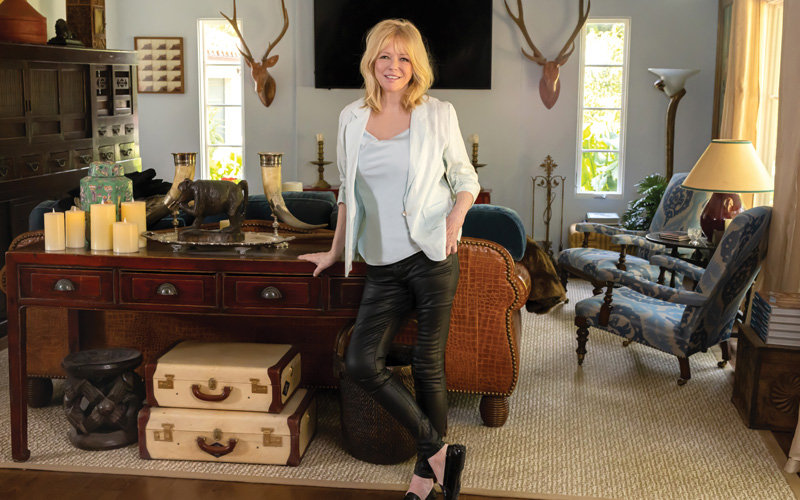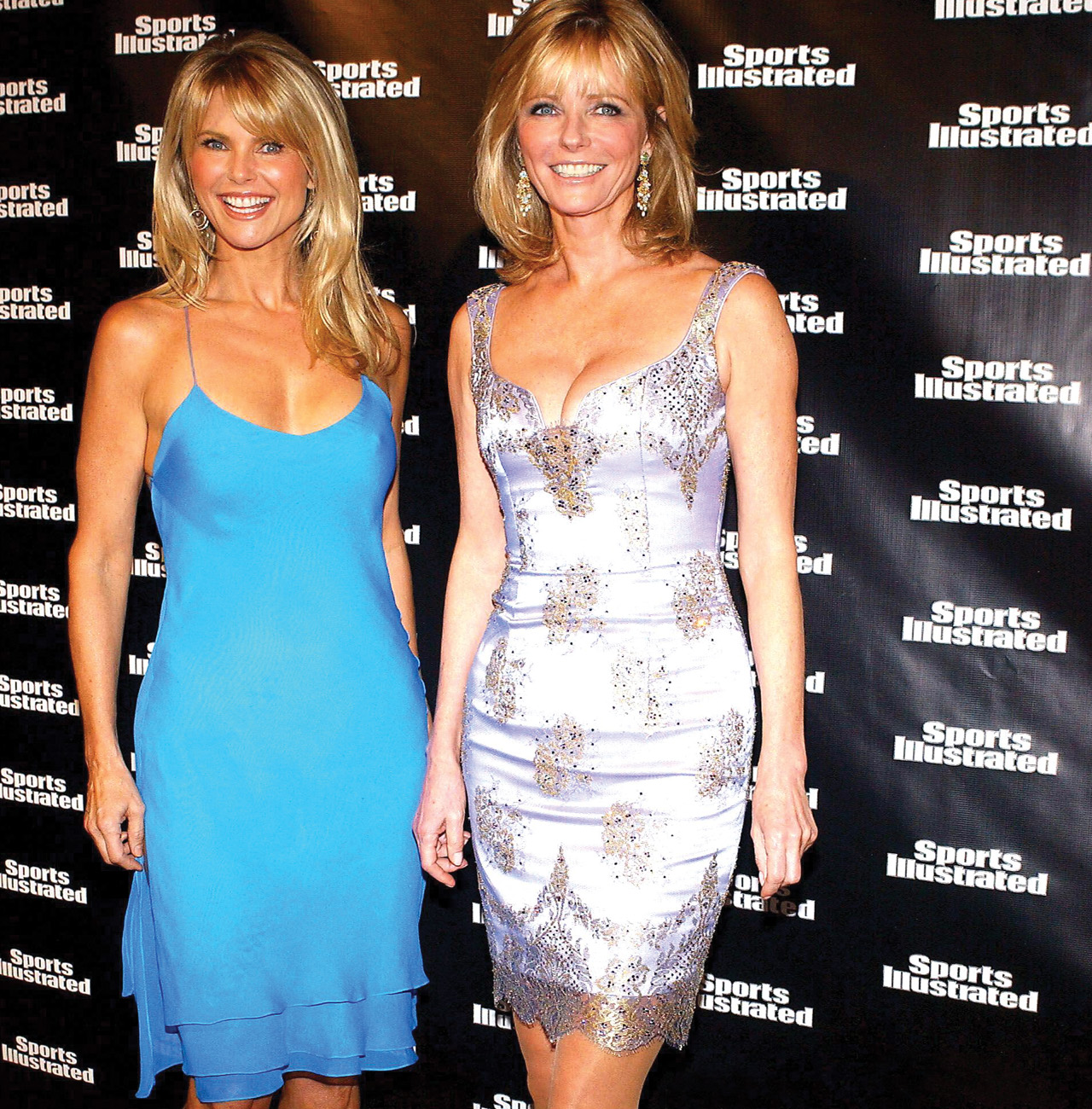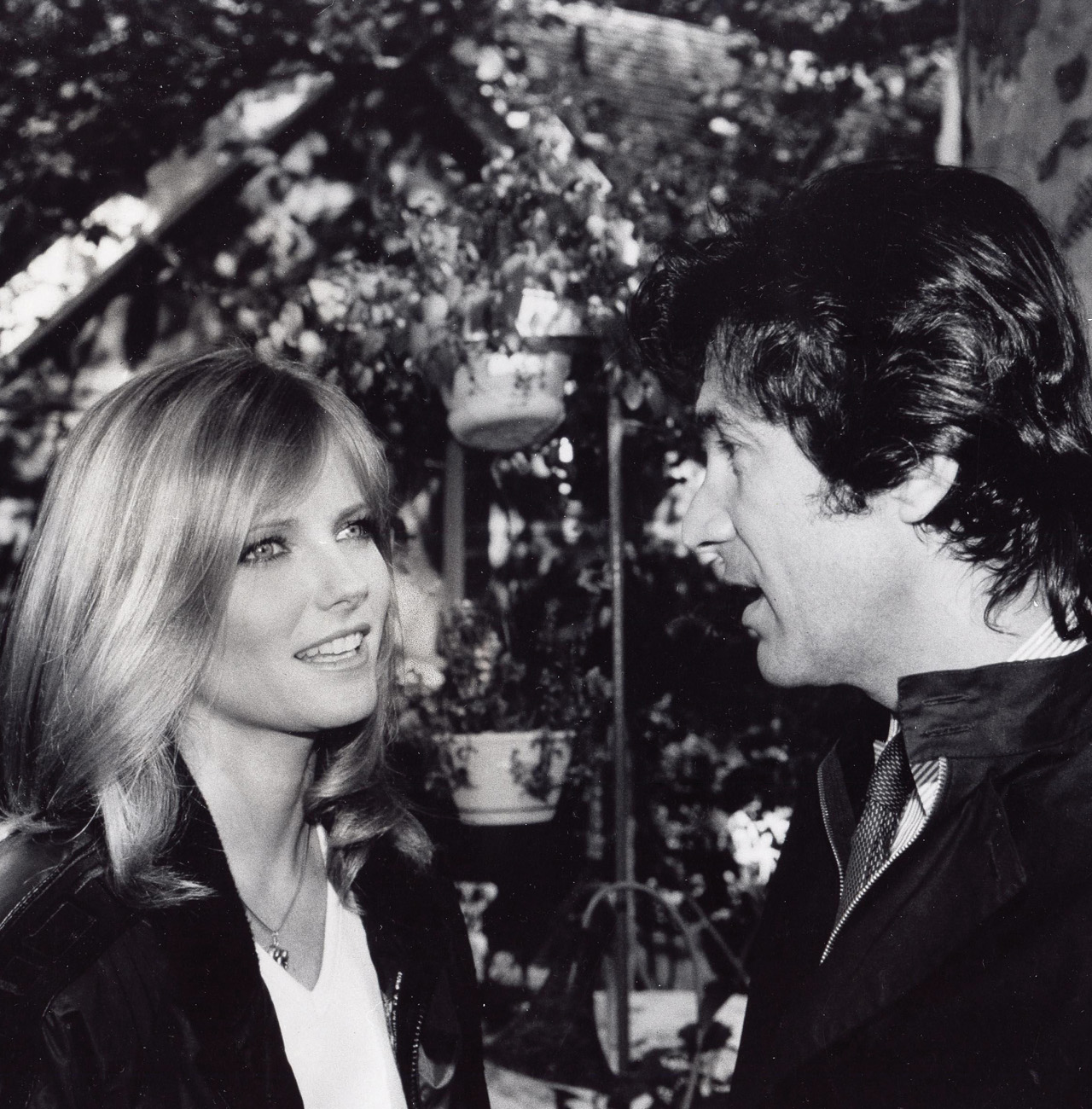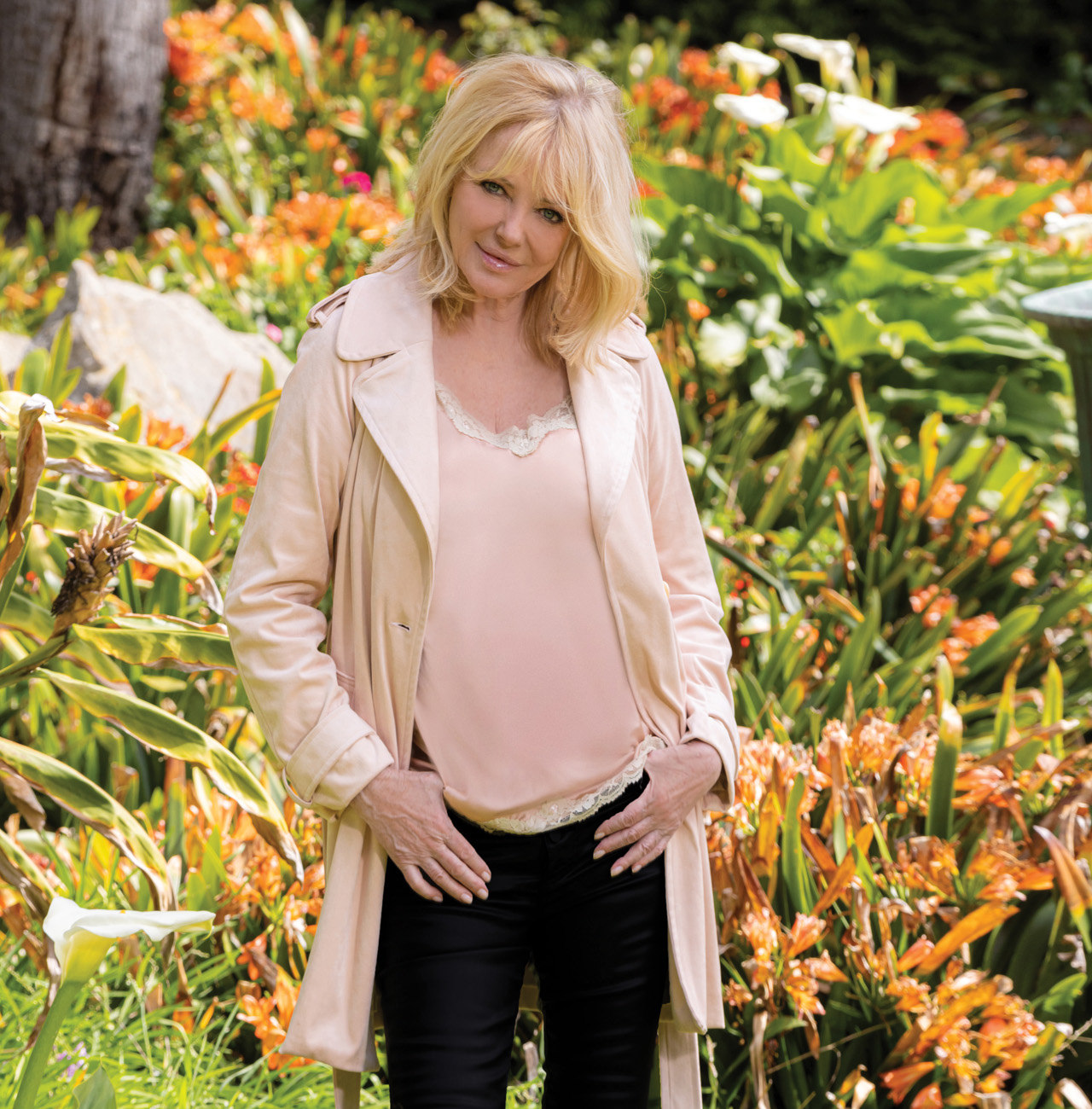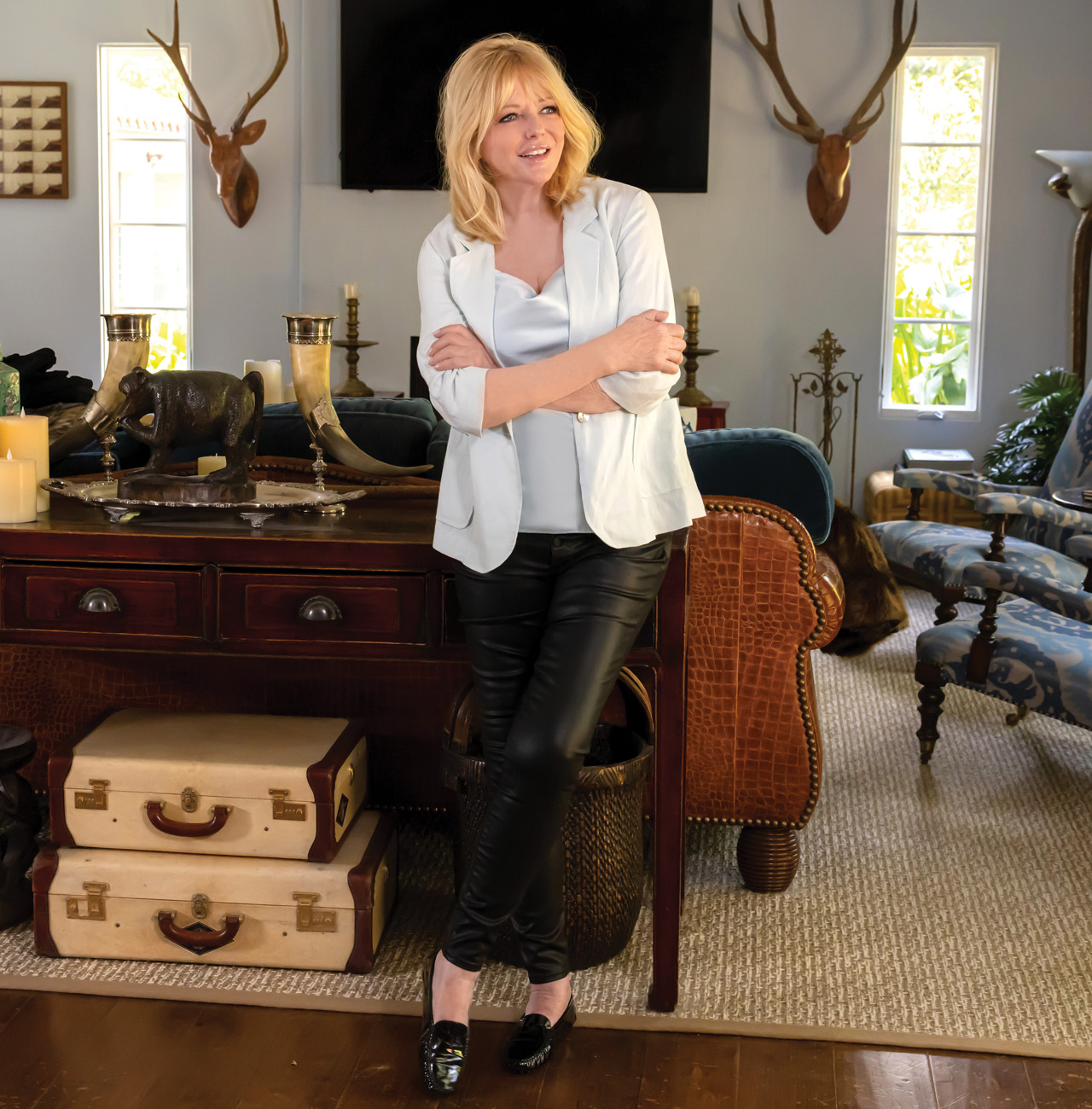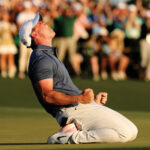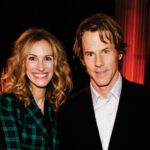Cheryl Tiegs – the world’s first Supermodel – has led a life that is vastly rich in accomplishments, adventure, and experiences. America’s quintessential natural beauty has lived and loved deeply while savoring all the elements that have made up the tapestry of her extensive life.
Despite a brilliantly successful and exciting journey, she has also had to weather disappointments and storms that have led to an emotional maturity honed from a choice to grow. Cheryl Tiegs has sucked the marrow out of life and arrived at a place of peace at her serene Montecito Mountain home.
As I walk into a house that speaks volumes about her, what immediately strikes me is Cheryl’s library of literary masterpieces. A lifelong voracious reader, she has an entire wall filled with hundreds of valuable books that are considered classical works of art. My respect for her is instantly established as we begin discussing how much books enrich our lives and the authors behind the valuable words. Cheryl’s extensive art collection is evident everywhere: she has masterpieces on her walls that belong to discerning tastes. There are also precious artifacts everywhere garnered from her extensive travels across the world. Each of them tells a wonderful story.
But Cheryl’s life began with the healing properties of nature, and that has been her lifelong rooting. She provides the description of her childhood landscape. “I spent the first five years of my life on a farm in Minnesota and I think that influenced the rest of my life. I was known as being very healthy and very fit. I like having my feet on the ground. Whenever I was on an airplane landing in Los Angeles, all I could think of was putting on my hiking shoes and getting out there into nature.” I ask her when and how she found her way into the modeling world. “My modeling career began when I was in high school,” she says. “I lived in Alhambra, California, a block away from Pasadena, and there was a modeling agent there who gave a talk to our sorority group at school. He addressed eleven of us and suggested that we pay him a visit.”
I ask her if he honed in on her specifically.
“Oh no,” she replies. “I certainly wasn’t a shining star, and he didn’t single me out. Interestingly, I was the only girl who actually went to see him. I started out doing many things for free, and in total I may have made about $5 but I loved it and was having a ball. My work was published and that made me happy. I went in with the mindset that I was going to give it a try, do my best, and go as far as it would take me. My ultimate goal was to be a librarian when the modeling ended. I’ve always loved reading.”
“I also took a couple of years off in the 70s because I married Stan Dragoti. My body really came into its own during those years, and when I returned to modeling later – I went into the high fashion sector which was Vogue and Harper’s Bazaar. It was another trajectory altogether.”
Cheryl went on to rise to the top of the industry – and she was the first model to appear three times on the cover of Sports Illustrated Swimsuit Issue. She was inducted into their ‘Hall of Fame’ at their 40th Anniversary. She was on the cover of Time Magazine four times and regards that as one of the highlights of her career.
March 1978, she was the cover story for Time Magazine, and it was called the ‘All American Model’.
Her career exploded. She was a consistent favorite on the covers of Vogue, Glamour Magazine, Harper’s Bazaar, Elle, Seventeen, People. She became one of the most recognizable faces worldwide as her career skyrocketed. I ask Cheryl if, at the time, she had any sense of how huge she had become. She answers matter-of-factly:
“I don’t think it ever really occurred to me. The only thing I remember being thrilled about was the cover story of Time Magazine. That’s when I became a household name and people would greet me as I walked down the street. I viewed it as a wonderful new phase in my life where I had millions of new friends. I really liked that.”
I ask Cheryl about all the places in the world that she visited in her career, and if that was something she relished. I receive an in-depth response.
Former SI models Christie Brinkley and Cheryl Tiegs arrive at the 2004 Sports Illustrated Swimsuit Issue press event for the 40th Anniversary Edition held at Deep in New York, on February 10, 2004. Photo by Nicolas Khayat/ABACA
“I became a household name when I was the cover story of Time Magazine, and people would greet me as I walked down the street. I viewed it as a wonderful new phase in my life where I had millions of new friends.”
“Yes, I think that was part of the glamor – visiting so many beautiful parts of the world. But I have to say that being a model is very much a solitary existence. You pack your bags, go to the Seychelles, you work with a crew, and you get to know them that week – and then you leave. The schedules are so packed that there is really no time to develop a friendship with anyone. It’s long hours of work, and then you have to sleep. I think it made me very independent; it made me capable of going to any place in the world – be it Honduras – or anywhere else. There would be a note for me advising me to check into a particular hotel. There was no technical gadget to steer me there, so I’d follow instructions assiduously – like going down four blocks and then turning left or right – then I’d climb a flight of stairs and meet up with members of the crew at a designated time. It was like a puzzle, and I became really good at figuring it all out and learning the lay of the land. I seldom relied on others, and I enjoyed that self-sufficiency. Traveling so much also taught me how to entertain myself. I remember going to an island populated by Italians who didn’t speak any English, and I made the most of every experience. I got along with everyone, imbibed the environment, and always brought a good book with me for company.”
The reason the title Supermodel was coined was to elevate women like Cheryl into a league of their own. These were astute women who took their modeling careers to new heights by becoming strategically savvy businesspeople. They became experts at marketing, negotiating, investing, and making their earnings multiply. Cheryl garnered one of the first huge contracts for Cover Girl Cosmetics. It was a $1.5 million contract – which back then – was a staggering amount of money. She explains.
“Cover Girl actually approached me and said, ‘we don’t want you to accept any other cosmetic contracts. We’d like you to work exclusively for us.’ I remember that the daily rate back then was $2,025 per day, and I decided to raise my rate to $3,500, and I think I put a shock wave through the whole industry.”
She looks back on that with a twinkle in her eyes, and then adds, “and that figure then became the bargaining standard for the top models. There really is a way to guide your career, and the models who did it successfully negated the image of models being ignorant or stupid. We knew exactly what we were doing, and it was important for us to become very good businesswomen. I also became adept at turning down certain advertisements because they weren’t high quality, and so I chose work wisely and I was always discerning. I never had a manager. All I had was an agent who procured bookings for me. Even then, I had a choice and if I didn’t think that something was good for my career, I walked away from it. I also recall drawing a line in the sand when companies would overwork us without a contract, and eventually I insisted that the business arrangement needed to be altered. If they wouldn’t put me on contract, then I was no longer available for slave labor.”
These were precedents that Cheryl laid down that helped future models in the industry. She emphasizes that for the most part, she loved her career and imbibed the special times with energetic gratitude.
1980 brought on another significant chapter in Cheryl’s career. She reinvigorated Sears completely by launching a signature clothing line for them. It was called the Cheryl Tiegs Collection and by 1989, it took Sears’ sales up by $1 billion. It was during that period that she was again on the cover of Time Magazine, and in the cover story, Time talked about Cheryl turning Sears around and they coined the phrase, ‘Sassy Sears’. Cheryl provides more details.
“The reason Sears took me on board is that they wanted to change their image to ‘Sassy Sears’ versus the old staid image. We did it and we worked very hard. Even though I was only supposed to open 17 days a year in my contract, I ended up giving them 317 days a year. I traveled around the country and spoke at conferences because I firmly believed in what we were doing, and I loved the work. The people there was so kind to me, and I got to go up into the Sears Tower. It was the tallest building in the world for a while.”
When I remark to Cheryl that she single-handedly took Sears to another frontier, she corrects that by crediting the team around her. It speaks to the power of people working constructively together with a powerful, shared vision.
“We did it together,” she emphasizes. “It was a great collaborative effort.”
Cheryl is quick to point out that she’s not the golden girl and that everything she touched didn’t necessarily turn to gold. There were some business ventures that bombed, but she learned from those experiences.
Cheryl’s love life is vastly expansive and enormously flavorful. Her first marriage was to Film Director, Stan Dragoti, in the 1970s when she was in her early twenties. I ask her if that was a happy time in her life.
Cheryl Tiegs and Stan Dragoti 1980: © Supplied by Globe Photos, Inc/Globe Photos/ZUMAPRESS.com)
Cheryl’s love life is vastly expansive and enormously flavorful. Her first marriage was to Film Director, Stan Dragoti, in the 1970s
“Oh yes,” she enthuses. “I loved Stan very much. He was 15 years older than I but that didn’t seem to matter. It was the only real marriage I had in the sense that he was very supportive of me, and I stopped modeling for a while so that I could be devoted to our marriage. We lived in Los Angeles, and every day I’d meet him for lunch. We bought a house together. Stan cautioned me, though, that I would get bored not working, and he was absolutely correct. I did get bored, and I went back to modeling. Stan was the kindest man I ever knew, and we were very happy.”
I ask why the marriage ended, and Cheryl muses: “I needed the stimulation of working again, and that involved a lot of traveling. Stan was very busy trying to get into the film business in Los Angeles, so we were on two very different paths. We went in different directions, but I have such wonderful memories of him and our time together.”
The next chapter of Cheryl’s life is like an epic movie, and I settle back in my chair while I listen to her marvelous capacity to re-tell the story like we were right there.
She moved to Kenya in Africa. It was vitally exotic, exciting, and she remembers it viscerally. She met famous photographer, Peter Beard, who was a refined, socially adept, and charming American aristocrat. They met while doing a show, ‘American Sportsman’ – a reality show where celebrities went on real-life adventures. Cheryl was with the American Sportsman team, and they did ‘End of the Game’ in Kenya (which ended up being awarded an Emmy), and that’s how she met the debonair Peter who lived on ‘Hog Ranch’. It was surrounded by Africa’s wild animals and Cheryl’s eyes twinkle particularly brightly as she describes their life there.
“We lived in Ralph Lauren-type tents – something I wouldn’t do today but back then it was so exciting to me. More than that, it was like heaven. The giraffe would walk by, and I’d survey their long legs as they walked past our tent. It was magical and I fell head over heels in love with Peter. I returned to Los Angeles to ask Stan (Dragoti) for a divorce and returned to Africa to be with Peter. Obviously, I traveled backwards and forwards with my work commitments, but whenever I was able, I came back to Kenya – a place that I loved.”
“I have a huge pile of letters from Peter – which I’ve kept – and in them he’d implore me to get back to Kenya because he missed me. As I’m talking to you, I’m experiencing flashbacks of exquisite moments that I’ll never forget. On one particular day, I was sitting in the African wilderness with my boots on, and I was writing in my diary while looking up and staring at the watering hole ahead. I was mesmerized by the beautiful picture in front of me. All these exotic animals came down there to quench their thirst. But I was transfixed by their behavior. I watched avidly how they protected their babies, and then a herd of elephants would arrive, and they all kind of got along, but sometimes, there’d be a skirmish – just like with humans. It really was like watching people at a cocktail party. I clearly remember the Bongo, which is a very large antelope, and despite its enormous size, it was so delicate. I was so drawn in by all the antics and the socialization of the animals at the watering hole. Africa really changed my life.”
I ask Cheryl how she evolved because of her time living in Africa with Peter. She responds thoughtfully.
“I like to be humbled by Mother Nature. I also truly understood the concept of being very still – for survival’s sake. When there is danger, it’s imperative to be statuesquely still. Alternatively, if some kind of shelter is nearby, one can carefully move towards it as inconspicuously as possible. The food chain really impacted me there. I’d watch a baby wildebeest being born, and as it dropped from its mother’s womb, there’d be six hyenas circling while making hungry cackling sounds. There’s such a fine and tenuous line between life and death in Africa. There’s an inevitability there with which one makes peace. But most of all, I remember the exhilaratingly terrifying moments.”
I can’t wait for the rest of the movie to unfold.
“One evening,” continues Cheryl, “I was walking in the dark towards the campfire when I heard the chilling vibrational growling of an African lion. I knew it was nearby. My instincts told me to slowly make my way back to my cabin and I did so – going without dinner that night. The key survival trick is to put your head down and avert looking at the lion. He mustn’t see your eyes.”
The tenuous membrane between life and death continues with Cheryl’s next recollection.
“I remember the famous bridge inhabited by the lion man-eaters of Tsavo. Caroline Kennedy had loaned us the Patterson’s Diary and it was left back in our van, and I was tasked with going back to the van to fetch it. When I got there, I found it filled with baboons, and all my survival skills came to the fore. I remember walking back extremely slowly and I kept my head right down. I retrieved the diary, and the baboons kept their eyes on me. That situation could have gone so badly wrong. Those are moments I’ll never forget.”
“My time with Peter Beard was one of the most thrilling periods of my life,” Cheryl concludes. “I was madly in love with him, and I learned so much. Peter was like the King of the Jungle there, but he took huge risks. He brought people like me much too close to the wild animals, and it upset conservationists like David Sheldrick. I recall Peter getting us much too close to elephant herds, and I memorized the warning signs that the elephant matriarch would give to us to back off. She rumbled and flapped her ears at us and eventually she charged. I dove behind an ant hill. There’s no question that Peter thrived on the danger of it all. He was also completely accurate on his assessment of there being too many people in the world all foraging for limited resources. He said that inevitably they would end up killing each other for survival. He was right.”
Cheryl’s Clothes: Ilene’s Boutique (818) 899-5060
“My time with Peter Beard was one of the most thrilling periods of my life. I was madly in love with him, and I learned so much. Peter was like the King of the Jungle there, but he took huge risks.”
Cheryl went on to marry Anthony Peck, the son of Gregory Peck. I ask her how it felt to marry into Hollywood Royalty. She remembers it with much affection.
“I was very shy back then, and it took a while for me to feel really comfortable with the Peck clan. I became close to Gregory’s wife, Veronique, and I still consider myself part of the Peck family.”
“It was an amazing time. When I think back on the dinner parties, every huge star in Hollywood would attend. Sharon Stone was a regular attendee, as was Roger Moore. We were all loved and accepted, and it was very special. In fact, Tony (Anthony) and I eloped to Palm Springs to the Frank Sinatra compound around Thanksgiving, and Frank walked me down the aisle at our wedding. There were only six of us at the wedding! It was thrilling and unique.”
Tony and Cheryl had a son, Zack, whom she clearly adores. “Zack really grew up to be quite a lovely fellow,” she says. “He is a very healthy adult who leads a happy, clean life. As we speak, he’s visiting Los Angeles (he and his family live in the English countryside) to start up a company.”
I ask Cheryl, if, looking back at her relationships, she recognizes that each man gave her something positive and special to hold onto in her memory bank. She replies:
“My first three marriages all gave me something very special and I have wonderful memories from those relationships.”
The same cannot be said of Cheryl’s fourth marriage, and she explains regrettably:
“My last marriage was to a yoga teacher, and I loved the words that came out of his mouth at classes. He was a very good teacher, but that warmth and vitality didn’t translate to our home. He was a completely different person on the home front – and he was by far the coldest man I’ve ever been with. It’s made me wary of orators with great stage presences.”
I learn through our extensive conversations that Cheryl is acutely aware of the struggles that people face, and she is well informed on a variety of human issues. She’s on the Board of ‘Earth Conservation Corps’. This organization helps young people who come from stressed communities. Some of them might have done jail time. They rehabilitate them by giving them meaningful work like cleaning up rivers. It’s a positive way to educate the next generation on the importance of our environment. Cheryl summarizes it succinctly: “It gives young people a chance to wake up in the morning and do something constructive with their lives.”
Cheryl’s humanitarian outreach is evident in many sectors. She’s passionate about ‘Project Angel Food’ – based in Los Angeles – and puts a great deal of time and effort into this.
“’Project Angel Food’ started when the A.I.D.S. crisis began in the 1980s,” she says. “A.I.D.S. patients couldn’t leave their homes to go out and get food, so the food is delivered to those who are home-bound. We deliver millions of meals up and down the west coast from Sacramento down to San Diego.”
Cheryl is also an ambassador for the International Planned Parenthood Foundation. She immediately clarifies that planned parenthood does not equal abortion. That’s an erroneous conclusion that people jump to. She explains.
“Planned parenthood means planning your family. I’ve traveled with the Foundation down to Ecuador and Honduras and encountered women who have to hide their birth-control pills because oftentimes the men don’t want their women to take them. These women live in very patriarchal societies where the men make decisions about childbirth even though it’s not they who have to take care of the multitude of children. Because the women know how much work children involve, they are desperate to give those that they do have a better quality of life by not bringing more children into the family.”
Farrah Fawcett, who battled cancer, was a dear friend of Cheryl’s, and she tries to keep Farrah’s vision alive with the Farrah Fawcett Foundation, although she’s not involved with it on a daily basis.
The nature-loving Cheryl continues to do her part in becoming as educated as possible on the effects of global warming. She describes multiple trips she’s made to the Arctic where the consequences are evident, particularly with the polar bears. The beauty of the habitat always impacts Cheryl. “One time they put me on a dog-drawn sled, and we had a local guide directing operations. The beauty was breathtaking. I’ve also spent a week there observing the Caribou migrating.”
Cheryl doesn’t require luxury when she’s immersed in nature. She’s backpacked into the Copper Canyon in Mexico for ten days and camped out in tents and sleeping bags.
The diversity of Cheryl’s career includes film work. She was in Vincent Gallo’s ‘The Brown Bunny’, and ‘Work Hard: The Dewey Cox Story’. She also featured in the Sports Illustrated exercise video called ‘Aerobic Interval Training’. She was the spokesperson for Deepak Chopra’s ‘Renewal: A Time for You’ which gives practical advice to women who are experiencing changes in their lives.
“Any transition,” Cheryl expands, “whether it’s menopause or a divorce, requires adjustment. ‘Renewal: A Time for You’ provides guidance and help through that transition process. It teaches you how to confront the issues; how to deal with them, and some things you just have to let go. We use tools such as meditation and yoga. My work and travels with Deepak Chopra were thrilling.”
I ask Cheryl what gives her immense joy at this stage in her life. Her response is immediate.
“Spending time with my son, Zack. Every second is pure joy. I learn so much from him, and hopefully he learns something from me. We have a very good relationship – one in which he can tell me his thoughts.”
“I also love the simple pleasures in life,” she continues, “like waking up in the morning. The fact that I no longer have to set the alarm at this stage in my life is such a huge relief. There is no strict time schedule. For so long my life was ruled by having to be at a certain destination at a certain time. I still have some PTSD from it. It gives me such joy now to wake up and do whatever I like. I can meet a friend or go on a hike; I can do whatever makes me happy. It took some adjustment to get into this peaceful phase because I have always been so used to a tight schedule. I also love and crave silence. This home gives me that serenity.”
Cheryl’s Clothes: Ilene’s Boutique (818) 899-5060
“Cover Girl asked me to work exclusively for them. The daily rate was $2,025 per day, and I raised my rate to $3,500, and I think I put a shock wave through the whole industry. That figure then became the bargaining standard for the top models. Those who did it successfully negated the image of models being ignorant or stupid. We knew exactly what we were doing, and it was important for us to become very good businesswomen.”
Cheryl’s warmly comfortable home is still in phases of unpacking. She’s deciding on a special place to archive Peter Beard’s heartfelt letters to her while they were separated and traveling across continents. Her humor tickles my senses as she describes the boxes of books she still has in storage downstairs.
“I won’t unpack them until I’ve built more shelves to put them into. I’m certainly not going to die from an avalanche of books falling on top of me!”
Many of those books are first editions, and there’s one that’s signed by Teddy Roosevelt.
Cheryl laughs at herself as she says, “I struggle in the art of down-sizing. I have so many artifacts from across the world. I can’t get rid of treasures that hold so many special memories for me.”
We come full circle as Cheryl emphasizes her gravitation to nature.
“I have always been passionate about nature, and it will continue to be my central point of reference,” she says with strong conviction.
I ask her what she is most of proud of.
“Raising a healthy, happy son,” she says unhesitatingly. But more expansively, she says, “being kind to people. It’s not always easy, but I try to prioritize it. I’m also proud of my work ethic, and looking back, I realize that I was a maverick. I was the first model to have done clothes for the mass market and I’m proud of that.”
Life often separates people logistically because of physical distance. Cheryl is experiencing that with her family.
“I would like to spend more time with my grandchildren,” she explains, “but the challenge is that they live in the English countryside, and moving there at this stage in my life is not an option.”
I ask her to paint a picture of an ideal day if she could choose to do anything she likes.
“Oooooo,” she says with satisfaction. “I love to wake up in the quietness of my home. I’d have breakfast while watching The View on TV. After that I’d hike with a friend because of the beauty of my surroundings. We’d probably come back to my home and have lunch and a chat. Every day I have an hour of power. I shut down all the gadgets in the house and go upstairs to my bedroom where I lie down with my hands on my hips. Sometimes I fall asleep and sometimes I don’t. I was raised as a Quaker and silence was at the core of our existence. So, I do that every day. After that, I’d probably go over to someone’s house for an early dinner, or we’d watch a movie together. It’s those simple things that make me happy.”
What struck me most after spending hours with Cheryl was her capacity to fully embrace life. Her vitality permeates into everything: the loves of her life, her work, her relaxation time, and her affinity to the natural environment. She’s mastered the art of embracing the present – and she captures and fully imbibes exquisitely sensitive moments. Cheryl Tiegs’ journey reflects her vast appetite for life, and it’s been an exhilarating ride.

